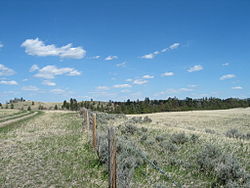

North Dakota's climate is typical of a continental climate with cold winters and warm-hot summers. The state's location in the Upper Midwest allows it to experience some of the widest variety of weather in the United States, and each of the four seasons has its own distinct characteristics. The eastern half of the state has a humid continental climate (Köppen climate classification Dfb and Dwb) with warm to hot, somewhat humid summers and cold, windy winters, while the western half has a semi-arid climate (Köppen climate classification BSk) with less precipitation and less humidity but similar temperature profiles. The areas east of the Missouri River get slightly colder winters, while those west of the stream get higher summer daytime temperatures. In general, the diurnal temperature difference is prone to be more significant in the west due to higher elevation and less humidity.
- ^ Galadriel Findlay Watson (2001). North Dakota. Weigl Publishers Inc. p. 8. ISBN 1-930954-53-0. Retrieved September 4, 2009.
